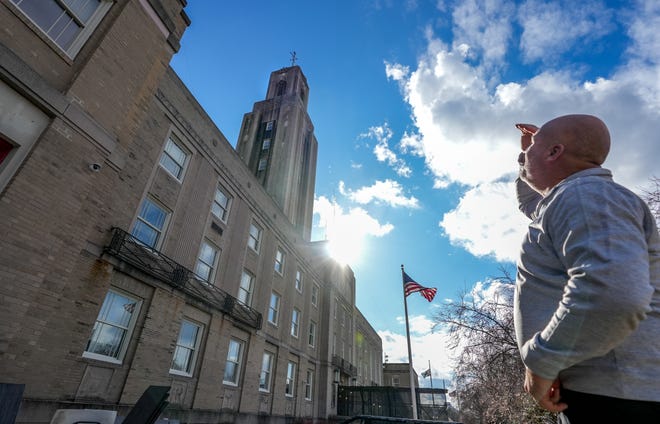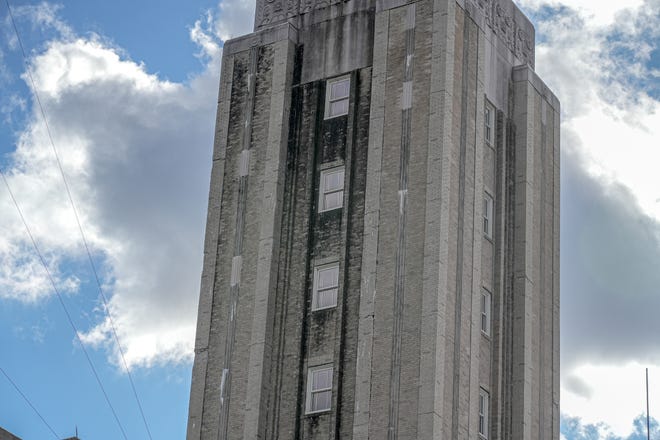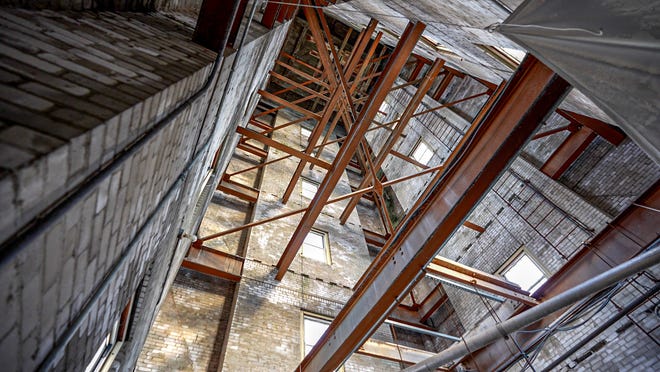
PAWTUCKET – Beneath the barrel-vaulted ceiling of the City Council chamber, next to rows of filing cabinets in the clerk’s office and beside the Christmas tree, big blue industrial dehumidifiers whir throughout City Hall.
They’re fighting an old enemy – rain – that for as long as many city workers can remember has been penetrating this 88-year-old Art Deco landmark. It might now be threatening its future.
With construction costs climbing, Pawtucket leaders are looking at major renovations to keep City Hall functioning at a time the city is also considering a new unified high school and public-safety complex.
And some members of the City Council – which is meeting Wednesday to discuss renovations – are now questioning whether a massive new investment in the Depression-era City Hall is worth it.
“Some people won’t like it because of the historic aspect, and it is a regal building, but it is a regal building that is costing us millions of dollars,” City Councilman Mark Wildenhain said Tuesday about the possibility of moving municipal offices out of City Hall. “I don’t think the taxpayers should continue to make that investment.”
The tower

To find the prime cause of City Hall’s constant water leaks, DPW Director Chris Crawley climbs a narrow, dusty staircase from the fourth floor into the drafty base of the hall’s 209-foot-plus high decorative tower.
Overhead, a lattice of steel buttresses the brick walls, and from some of the lower beams hangs a web of plastic sheeting and rubber hoses designed to collect leaking water. The hoses feed into plastic buckets like an elaborate garden irrigation system, and when each bucket fills, a worker brings it downstairs to dump out.
“This where the brick is deteriorating,” Crawley said opening a metal door from the tower base that leads to the building’s roof. “The rain comes in and soaks through … We try to minimize what’s getting into the building and try to capture everything here.”
A ladder of metal rungs leads to a platform at the top of the tower, which is not open to the public and which Crawley says he has never been on.

Pawtucket City Hall was built between 1933 and 1936 under the direction of Mayor Thomas McCoy. Like another leaky Pawtucket landmark of the same era, McCoy Stadium, it was funded by the federal Works Progress Administration.
“It is the monumental City Hall, though, with its soaring, landmark tower, which most appropriately memoralizes ‘Boss’ Tom McCoy and his era of machine rule in Pawtucket,” the City Hall nomination to the National Register nomination says.
Right up to the damaged plaster, a remarkable amount of the 1930s details of the building remain, from light fixtures to metal work and dark wood paneling.
Repairs
The tower has been a maintenance headache for years. A masonry eagle fell off in 1974 and the city renovated the tower to plug the leaks in 2005, but it didn’t take long for the water to start getting in again.
Fluctuating temperature and humidity eat away the steel and cause separation from the brick, Crawley said.
This summer, scaffolding was installed above the front steps and walkway to protect residents from any bricks that might fall off the tower.
In 2016, Pawtucket voters approved a $5-million bond to renovate the tower, but as Mayor Donald Grebien’s administration looked into what it would take to solve the problem, it has become clear that sum won’t be nearly enough.
“The project was put on hold due to budgetary considerations,” Grebien spokesperson Grace Voll said about why the tower project didn’t advance after the 2016 vote. “In conversations with City Council Leadership at the time, the Mayor agreed that projects like school construction and road rehabilitation were more important than putting this additional debt service payment on the books. Taxpayers could not afford additional increases at the time.”
Cost
Earlier this month Downes Construction, the city’s project manager, said based on bids it has received it will cost $22 million just for exterior renovation of the tower. And that number could go up if the condition of the structural steel turns out to be worse than expected.
The new estimate, presented to the council and first reported by the Valley Breeze, recommended that during construction, city workers be moved to temporary offices in 100 Freight St. (The police and fire departments, which occupy wings on either end of City Hall, would not be affected.)
Given the cost and scale of the disruption just to plug the tower leaks, a wide range of other options is now being considered.

They range from getting rid of the tower, which would violate the historical look of the building, to renovating the entire building and the tower.
Crawley said a bigger project would probably include new elevators, bathrooms, boilers, masonry, electrical service and windows.
Adding to the complexity, if the city begins upgrading things beyond the tower, it will trigger accessibility, building and fire code compliance, he said. The building does not have sprinklers.
Grebien is holding off on recommending a preferred long-term solution until council members have heard a presentation Wednesday and had “time to digest and discuss the next steps,” Voll said.
“It is unclear how the city would pay for the tower renovation, and the most likely source of funding would have to be a 2024 ballot question,” she wrote in an email.
If the cost of repair is unpalatable, there is also the option to move out.
Wildenhain said he believes fixing the whole building and the tower would cost between $30 million and $40 million.
And even then, there is no guarantee the leaks won’t begin again after a few years.
If the city offices were permanently moved out of City Hall to a new location, Wildenhain said the most likely use for the old building would be offering it to developers for possible conversion to apartments.
“I appreciate history just like everyone else does, and if there was a feasible way to do it, I would,” he said.